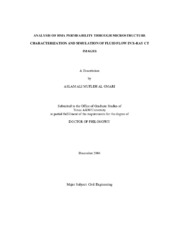| dc.contributor.advisor | Masad, Eyad | |
| dc.creator | Al Omari, Aslam Ali Mufleh | |
| dc.date.accessioned | 2005-02-17T21:01:56Z | |
| dc.date.available | 2005-02-17T21:01:56Z | |
| dc.date.created | 2004-12 | |
| dc.date.issued | 2005-02-17 | |
| dc.identifier.uri | https://hdl.handle.net/1969.1/1454 | |
| dc.description.abstract | The infiltration of water in asphalt pavements promotes moisture damage primarily through damaging the binder cohesive bond and the adhesive bond between aggregates and binder. Moisture damage is associated with excessive deflection, cracking, and rutting. The first step in addressing the problems caused by the presence of water within pavement systems is quantifying the permeability of hot mix asphalt (HMA) mixes. This dissertation deals with the development of empirical-analytical and numerical
approaches for predicting the permeability of HMA. Both approaches rely on the analysis of air void distribution within the HMA microstructure.
The empirical-analytical approach relies on the development of modified forms of the Kozeny-Carman equation and determining the material properties involved in this equation through three dimensional microstructure analyses of X-ray Computed Tomography (CT) images. These properties include connected percent air voids
(effective porosity), tortuosity, and air void specific surface area. A database of materials and permeability measurements was used to verify the developed predicting equation. The numerical approach, which is the main focus of this study, includes the development of a finite difference numerical simulation model to simulate the steady incompressible fluid flow in HMA. The model uses the non-staggered system that utilizes only one cell to solve for all governing equations, and it is applicable for cell Reynolds number (Rec) values that are not restricted by |Rec|≤2. The validity of the numerical model is verified through comparisons with closed-form solutions for idealized microstructure. The numerical model was used to find the components of the three-dimensional (3-D) permeability tensor and permeability anisotropy values for different types of HMA
mixes. It was found that the principal permeability directions values are almost in the
horizontal and vertical directions with the maximum permeability being in the horizontal
direction. | en |
| dc.format.extent | 1693648 bytes | en |
| dc.format.medium | electronic | en |
| dc.format.mimetype | application/pdf | |
| dc.language.iso | en_US | |
| dc.publisher | Texas A&M University | |
| dc.subject | Fluid flow | en |
| dc.subject | Permeability | en |
| dc.subject | HMA | en |
| dc.subject | Simulation | en |
| dc.subject | X-ray CT | en |
| dc.subject | 3-D Microstructures | en |
| dc.title | Analysis of HMA permeability through microstructure characterization and simulation of fluid flow in X-ray CT images | en |
| dc.type | Book | en |
| dc.type | Thesis | en |
| thesis.degree.department | Civil Engineering | en |
| thesis.degree.discipline | Civil Engineering | en |
| thesis.degree.grantor | Texas A&M University | en |
| thesis.degree.name | Doctor of Philosophy | en |
| thesis.degree.level | Doctoral | en |
| dc.contributor.committeeMember | Glover, Charles | |
| dc.contributor.committeeMember | Little, Dallas | |
| dc.contributor.committeeMember | Chen, Hamn-Ching | |
| dc.contributor.committeeMember | Lytton, Robert | |
| dc.type.genre | Electronic Dissertation | en |
| dc.type.material | text | en |
| dc.format.digitalOrigin | born digital | en |


